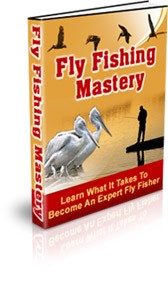 License Type: Master Resell Rights
License Type: Master Resell Rights  File Size: 353 KB
File Size: 353 KB File Type: ZIP
File Type: ZIP
 SKU: 11038
SKU: 11038  Shipping: Online Download
Shipping: Online Download
Ebook Sample Content Preview:
Experienced fishermen carefully watch or "read" the water. They will fish the areas that have all the requirements the fish want and skip over the areas that don't have everything the fish need. So, what keeps fish in a certain part of the water? Fish like the rest of us have basic needs these are food, cover, and a resting place. Fish sometimes will look for warmer water in the spring when the water is uncomfortably cold and sometimes they will look for cooler water in the summer when water temperatures rise. When fish are looking for warmer water they will go to a shallow area of the stream where the sun has warmed up the temperature of the water a few degrees. In the hot summer time they will look for the mouth of a small feeder spring where the water is cooler. These are examples of fish seeking comfort. It is helpful when you are fly fishing if you will start thinking like a fish.
Since you are thinking like a fish, now let's find out what they will bite at. Forget the notion that one fly works better than the others. Some of the flies may work better in the summer than other flies because the flies you are using are around that time of the year. Trout may bite at hoppers during the month of August because hoppers are around that time of year. If you tried them in March, the fish won't bite them. The fish will only eat what they see on a regular basis.
One of the first steps to becoming a successful fly fisherman is not fishing. You need to observe what is going on around the area you want to fish. Watch how the fish are behaving, what they are doing. Look around for clues that any new hatches that have occurred. Check on and around the grass stems and weeds near the shoreline for clues of a recent hatch. Stonefly nymphs crawl out of the water to hatch into adults. The transformation will occur on a grass stem, weed, rock or anything close to the shoreline. Mayflies shed their outer covering after they hatch. This also happens on grass and weeds. Look around for clues. You might also look for any aquatic insects crawling around on nearby bushes. The bushes are a great hangout for aquatic insects that have recently hatched and are waiting until it is their time to lay eggs. When you see a lot of a certain kind of insect hanging around the bushes, you will know that to use that particular insect pattern imitating that insect will do well when fishing with them in the stream.
You can get other clues by watching the fish. If they are rising to the surface to catch flies, maybe you can see what kind of fly they are eating. If you don't see the fish rising, it maybe a nymph would work better. Nymphs are available to the fish all of the time.
Make a net of fine mesh stretched between two rods. This tool will also help you determine what is floating in the stream. Stretch the net across the water near the shore and then do the same thing in the middle of the stream. The results might differ some, but if you see a lot of the same type of insect in both nettings, you'll have a good idea of the type of bait you should be using.
Get a notebook to record your findings for future references. You might be surprised to see that the findings you found the first year match what you find on the second year for the same time of year and the same water spot. In a couple of years you will have a good database for you to use when selecting flies for upcoming fishing trip.
Fifteen minutes of your time spent looking for clues versus several hours of catching nothing during your next fishing trip. All it takes is a few minutes of watching without a fly rod in your hand.
Most of the fly fishermen started out as conventional fishermen with a spin cast rod rather than of a fly rod. So it is only natural that the things you learned in conventional fishing you would try in fly fishing and "hooking them" should be one of them. So if you haven't learned how to hook a fish with a fly rod, you need to start now.
Although a fly rod seems flexible, you should not stagger backward with the rod on the strike. The rod will probably break. Take things a little easier. A spinning line will stretch like a rubber band where as a fly line will not. Since you will be using a smaller and lighter wire hook than in spinning, they require almost no "hook setting" at all.
- File Size:353 KB
- License: Master Resell Rights
- Category:Ebooks
- Tags:2007 Ebook Master Resale Rights








